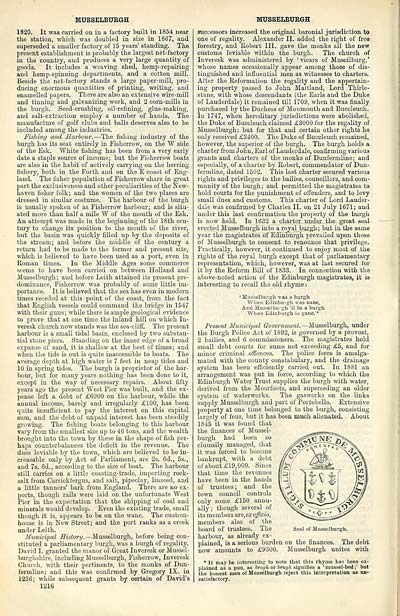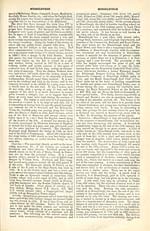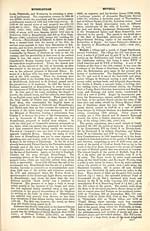Ordnance gazetteer of Scotland
(1224) Page 1216 - MUS
Download files
Complete book:
Individual page:
Thumbnail gallery: Grid view | List view

MUSSELBURGH
1820. It was carried on in a factory built in 1854 near
the station, which was doubled in size in 1867, and
superseded a smaller factory of 15 years' standing. The
present establishment is probably the largest net-factory
in the country, and produces a very large quantity of
goods. It includes a weaving shed, hemp-repairing
and hemp-spinning departments, and a cotton mill.
Beside the net-factory stands a large paper-mill, pro-
ducing enormous quantities of printing, writing, and
enamelled papers. There are also an extensive wire-mill
and tinning and galvanizing work, and 2 corn-mills in
the burgh. Seed-crushing, oil-refining, glue-making,
and salt-extraction employ a number of hands. The
manufacture of golf clubs and balls deserves also to be
included among the industries.
Fishing and Harbour. — The fishing industry of the
burgh has its seat entirely in Fisherrow, on the W side
of the Esk. White fishing has been from a very early
date a staple source of income; but the Fisherrow boats
are also in the habit of actively carrying on the herring
fishery, both in the Forth and on the E coast of Eng-
land. The fisher population of Fisherrow share in great
part the exclusiveness and other peculiarities of the New-
haven fisher folk; and the women of the two places are
dressed in similar costume. The harbour of the burgh
is usually spoken of as Fisherrow harbour; and is situ-
ated more than half a mile W of the mouth of the Esk.
An attempt was made in the beginning of the ISth cen-
tury to change its position to the mouth of the river,
but the basin was quickly filled up by the deposits of
the stream; and before the middle of the century a
return had to be made to the former and present site,
which is believed to have been used as a port, even in
Roman times. In the Middle Ages some commerce
seems to have been carried on between Holland and
Musselburgh ; and before Leith attained its present pre-
dominance, Fisherrow was probably of some little im-
portance. It is believed that the sea has even in modem
times receded at this point of the coast, from the fact
that English vessels could command the bridge in 1547
with their guns; while there is ample geological evidence
to prove that at one time the inland hill on which In-
veresk church now stands was the sea-cliff. The present
harbour is a small tidal basin, enclosed by two substan-
tial stone piers. Standing on the inner edge of a broad
expanse of sand, it is shallow at the best of times; and
when the tide is out is quite inaccessible to boats. The
average depth at high water is 7 feet in neap tides and
10 in spring tides. The burgh is proprietor of the har-
bour, but for many years nothing has been done to it,
except in the way of necessary repairs. About fifty
years ago the present West Pier was built, and the ex-
pense left a debt of £6000 on the harbour, while the
annual income, barely and irregularly £100, has been
quite insufficient to pay the interest on this capital
sum, and the debt of unpaid interest has been steadily
growing. The fishing boats belonging to this harbour
vary from the smallest size up to 46 tons, and the wealth
brought into the town by these in the shape of fish per-
haps counterbalances the deficit in the revenue. The
dues leviable by the town, which are believed to be in-
creasable only by Act of Parliament, are 2s. 6d., 5s.,
and 7s. 6d., according to the size of boat. The harbour
still carries on a little coasting-trade, importing rock-
salt from Carrickfergus, and salt, pipeclay, linseed, and
a little tanners' bark from England. There are no ex-
ports, though rails were laid on the unfortunate West
Pier in the expectation that the shipping of coal and
minerals would develop. Even the existing trade, small
though it is, appears to be on the wane. The custom-
house is in New Street; and the port ranks as a creek
under Leith.
Municipal History. — Musselburgh, before being con-
stituted a parliamentary burgh, was a burgh of regality.
David I. granted the manor of Great Inveresk or Mussel-
burghshire, including Musselburgh, Fisherrow, Inveresk
Church, with their pertinents, to the monks of Dun-
fermline; and this was confirmed by Gregory IX. in
1236; while subsequent grants by certain of David's
1216
MUSSELBURGH
successors increased the original baronial jurisdiction to
one of regality. Alexander II. added the right of free
forestry, and Robert III. gave the monks all the new
customs leviable within the burgh. The church of
Inveresk was administered by ' vicars of Muscilburg, '
whose names occasionally appear among those of dis-
tinguished and influential men as witnesses to charters.
After the Reformation the regality and the appertain-
ing property passed to John Maitland, Lord Thirle-
stane, with whose descendants (the Earls and the Duke
of Lauderdale) it remained till 1709, when it was finally
purchased by the Duchess of Monmouth and Buccleuch.
In 1747, when hereditary jurisdictions were abolished,
the Duke of Buccleuch claimed £3000 for the regality of
Musselburgh; but for that and certain other rights he
only received £3400. The Duke of Buccleuch remained,
however, the superior of the burgh. The burgh holds a
charter from John, Earl of Lauderdale, confirming various
grants and charters of the monks of Dunfermline; and
especially, of a charter by Robert, eommendator of Dun-
fermline, dated 1502. This last charter secured various
rights and privileges to the bailies, councillors, and com-
munity of the burgh ; and permitted the magistrates to
hold courts for the punishment of offenders, and to levy
small dues and customs. This charter of Lord Lauder-
dale was confirmed by Charles II. on 21 July 1671; and
under this last confirmation the property of the burgh
is now held. In 1632 a charter under the. great seal-
erected Musselburgh into a royal buigh ; but in the same
year the magistrates of Edinburgh prevailed upon those
of Musselburgh to consent to renounce that privilege.
Practically, however, it continued to enjoy most of the
rights of the royal burgh except that of parliamentary
representation, which, however, was at last secured for
it by the Reform Bill of 1833. In connection with the
above-noted action of the Edinburgh magistrates, it is
interesting to recall the old rhyme :
' Musselburgh was a burgh
When Edinburgh was nane,
And Musselburgh '11 be a burgh
When Edinburgh is gane.'*
Present Municipal Government. — Musselburgh, under
the Burgh Police Act of 1892, is governed by a provost,
2 bailies, and 6 commissioners. The magistrates hold
small debt courts for sums not exceeding £5, and for
minor criminal offences. The police force is amalga-
mated with the county constabulary, and the drainage
system has been efficiently carried out. In 1881 an
arrangement was put in force, according to which the
Edinburgh Water Trust supplies the burgh with water,
derived from the Moorfoots, and superseding an older
system of waterworks. The gasworks on the links
supply Musselburgh and part of Portobello. Extensive
property at one time belonged to the burgh, consisting
largely of feus, but it has been much alienated. About
1845 it was found that
the finances of Mussel-
burgh had been so
clumsily managed, that
it was forced to become
bankrupt, with a debt
of about £19, 000. Since
that time the revenues
have been in the hands
of trustees; and the
town council controls
only some £150 annu-
ally; though several of
its members are, ex officio,
members also of the
board of trustees. The
harbour, as already ex-
plained, is a serious burden on the finances. The debt
now amounts to £9300. Musselburgh unites with
* It may be interesting to note that this rhyme has been ex-
plained aa a pun, as brotih or brugh signifies a 'mussel-bed;' but
the honest men of Musselburgh reject this interpretation as un-
satisfactory.
Seal of Musselburgh.
1820. It was carried on in a factory built in 1854 near
the station, which was doubled in size in 1867, and
superseded a smaller factory of 15 years' standing. The
present establishment is probably the largest net-factory
in the country, and produces a very large quantity of
goods. It includes a weaving shed, hemp-repairing
and hemp-spinning departments, and a cotton mill.
Beside the net-factory stands a large paper-mill, pro-
ducing enormous quantities of printing, writing, and
enamelled papers. There are also an extensive wire-mill
and tinning and galvanizing work, and 2 corn-mills in
the burgh. Seed-crushing, oil-refining, glue-making,
and salt-extraction employ a number of hands. The
manufacture of golf clubs and balls deserves also to be
included among the industries.
Fishing and Harbour. — The fishing industry of the
burgh has its seat entirely in Fisherrow, on the W side
of the Esk. White fishing has been from a very early
date a staple source of income; but the Fisherrow boats
are also in the habit of actively carrying on the herring
fishery, both in the Forth and on the E coast of Eng-
land. The fisher population of Fisherrow share in great
part the exclusiveness and other peculiarities of the New-
haven fisher folk; and the women of the two places are
dressed in similar costume. The harbour of the burgh
is usually spoken of as Fisherrow harbour; and is situ-
ated more than half a mile W of the mouth of the Esk.
An attempt was made in the beginning of the ISth cen-
tury to change its position to the mouth of the river,
but the basin was quickly filled up by the deposits of
the stream; and before the middle of the century a
return had to be made to the former and present site,
which is believed to have been used as a port, even in
Roman times. In the Middle Ages some commerce
seems to have been carried on between Holland and
Musselburgh ; and before Leith attained its present pre-
dominance, Fisherrow was probably of some little im-
portance. It is believed that the sea has even in modem
times receded at this point of the coast, from the fact
that English vessels could command the bridge in 1547
with their guns; while there is ample geological evidence
to prove that at one time the inland hill on which In-
veresk church now stands was the sea-cliff. The present
harbour is a small tidal basin, enclosed by two substan-
tial stone piers. Standing on the inner edge of a broad
expanse of sand, it is shallow at the best of times; and
when the tide is out is quite inaccessible to boats. The
average depth at high water is 7 feet in neap tides and
10 in spring tides. The burgh is proprietor of the har-
bour, but for many years nothing has been done to it,
except in the way of necessary repairs. About fifty
years ago the present West Pier was built, and the ex-
pense left a debt of £6000 on the harbour, while the
annual income, barely and irregularly £100, has been
quite insufficient to pay the interest on this capital
sum, and the debt of unpaid interest has been steadily
growing. The fishing boats belonging to this harbour
vary from the smallest size up to 46 tons, and the wealth
brought into the town by these in the shape of fish per-
haps counterbalances the deficit in the revenue. The
dues leviable by the town, which are believed to be in-
creasable only by Act of Parliament, are 2s. 6d., 5s.,
and 7s. 6d., according to the size of boat. The harbour
still carries on a little coasting-trade, importing rock-
salt from Carrickfergus, and salt, pipeclay, linseed, and
a little tanners' bark from England. There are no ex-
ports, though rails were laid on the unfortunate West
Pier in the expectation that the shipping of coal and
minerals would develop. Even the existing trade, small
though it is, appears to be on the wane. The custom-
house is in New Street; and the port ranks as a creek
under Leith.
Municipal History. — Musselburgh, before being con-
stituted a parliamentary burgh, was a burgh of regality.
David I. granted the manor of Great Inveresk or Mussel-
burghshire, including Musselburgh, Fisherrow, Inveresk
Church, with their pertinents, to the monks of Dun-
fermline; and this was confirmed by Gregory IX. in
1236; while subsequent grants by certain of David's
1216
MUSSELBURGH
successors increased the original baronial jurisdiction to
one of regality. Alexander II. added the right of free
forestry, and Robert III. gave the monks all the new
customs leviable within the burgh. The church of
Inveresk was administered by ' vicars of Muscilburg, '
whose names occasionally appear among those of dis-
tinguished and influential men as witnesses to charters.
After the Reformation the regality and the appertain-
ing property passed to John Maitland, Lord Thirle-
stane, with whose descendants (the Earls and the Duke
of Lauderdale) it remained till 1709, when it was finally
purchased by the Duchess of Monmouth and Buccleuch.
In 1747, when hereditary jurisdictions were abolished,
the Duke of Buccleuch claimed £3000 for the regality of
Musselburgh; but for that and certain other rights he
only received £3400. The Duke of Buccleuch remained,
however, the superior of the burgh. The burgh holds a
charter from John, Earl of Lauderdale, confirming various
grants and charters of the monks of Dunfermline; and
especially, of a charter by Robert, eommendator of Dun-
fermline, dated 1502. This last charter secured various
rights and privileges to the bailies, councillors, and com-
munity of the burgh ; and permitted the magistrates to
hold courts for the punishment of offenders, and to levy
small dues and customs. This charter of Lord Lauder-
dale was confirmed by Charles II. on 21 July 1671; and
under this last confirmation the property of the burgh
is now held. In 1632 a charter under the. great seal-
erected Musselburgh into a royal buigh ; but in the same
year the magistrates of Edinburgh prevailed upon those
of Musselburgh to consent to renounce that privilege.
Practically, however, it continued to enjoy most of the
rights of the royal burgh except that of parliamentary
representation, which, however, was at last secured for
it by the Reform Bill of 1833. In connection with the
above-noted action of the Edinburgh magistrates, it is
interesting to recall the old rhyme :
' Musselburgh was a burgh
When Edinburgh was nane,
And Musselburgh '11 be a burgh
When Edinburgh is gane.'*
Present Municipal Government. — Musselburgh, under
the Burgh Police Act of 1892, is governed by a provost,
2 bailies, and 6 commissioners. The magistrates hold
small debt courts for sums not exceeding £5, and for
minor criminal offences. The police force is amalga-
mated with the county constabulary, and the drainage
system has been efficiently carried out. In 1881 an
arrangement was put in force, according to which the
Edinburgh Water Trust supplies the burgh with water,
derived from the Moorfoots, and superseding an older
system of waterworks. The gasworks on the links
supply Musselburgh and part of Portobello. Extensive
property at one time belonged to the burgh, consisting
largely of feus, but it has been much alienated. About
1845 it was found that
the finances of Mussel-
burgh had been so
clumsily managed, that
it was forced to become
bankrupt, with a debt
of about £19, 000. Since
that time the revenues
have been in the hands
of trustees; and the
town council controls
only some £150 annu-
ally; though several of
its members are, ex officio,
members also of the
board of trustees. The
harbour, as already ex-
plained, is a serious burden on the finances. The debt
now amounts to £9300. Musselburgh unites with
* It may be interesting to note that this rhyme has been ex-
plained aa a pun, as brotih or brugh signifies a 'mussel-bed;' but
the honest men of Musselburgh reject this interpretation as un-
satisfactory.
Seal of Musselburgh.
Set display mode to: Large image | Transcription
Images and transcriptions on this page, including medium image downloads, may be used under the Creative Commons Attribution 4.0 International Licence unless otherwise stated. ![]()
| Gazetteers of Scotland, 1803-1901 > Ordnance gazetteer of Scotland > (1224) Page 1216 - MUS |
|---|
| Permanent URL | https://digital.nls.uk/97407934 |
|---|

